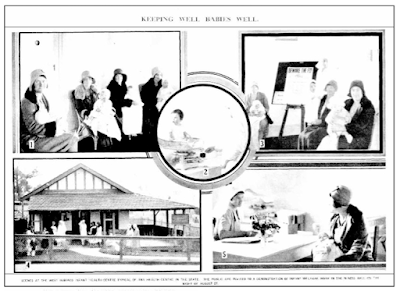A Baby Competition And The Subiaco Infant Health Centre (1929).
Trove, the database on the National Library of Australia provides newspaper articles about the history and work being done of the Subiaco Infant Health Centre in the late 1920's and early 1930's. Dr Roberta Jull, the first woman in Western Australia to establish a medical practice in Perth and interested in improving infant and mother welfare was asked to be a judge for the baby competition to raise funds for the Centre in 1927. Dr. Roberta Jull wrote a letter to the committee about her thoughts on judging babies in competitions. She stated these competitions were of no "educative value to the community" and infants should only be judged under specific circumstances and politely declined their request. Dr. Jull did visit the Centre in September 1927.
In the early years infant health care at the Subiaco Infant Health Centre involved the mothers and infants visiting the centre for a check up with the sister in charge who provided assistance and advice and referred those in need to a doctor. The sister also visited the homes of mothers and infants. This assistance and advice was in addition to the work being done by doctors who supported the centres. In 1926 the Social Service Workers were interested in establishing a list of families interested in supporting mothers with infants who needed to go into hospital for medical treatment but had no suitable people to care for their infants. (The West Australian 4 November, 1926). Although the work being done at infant health centres was recognised as essential to the care of mothers and infants in the community they still depended on donations and fund raising.
One of the ways funding was raised was by holding competitions in which infants competed against each other for prize money. Dr. Roberta Jull was asked to be a judge in this competition. She wrote this reply which was published in The West Australian. "...Kindly convey to the members of your committee my appreciation of the honour they have done me in asking me to be one of the judges in the proposed baby competition. May I take the liberty of asking the committee to reconsider the holding of the competition so far as the babies are concerned, and of suggesting that only a decorated perambulator, and a baby - decorated or not as may be decided - be made the subject of competition ? Were that done I should be delighted to be one of the judges, but I must regretfully decline to judge babies. As usually conducted, baby show are of no educative value to the community, and are a source of much heart-burning and dissension. The only way in which they can be justified is when they are held under strict conditions as to qualifications desired, such as regular attendance of at least six months at a centre, attention to advice give ect. ect. Not only the baby's appearance should be taken into account, but efficient mothering show in breast-feeding, choice of clothing, absence of dummy and so on.
If your committee so wished, it might be possible for me to help to organise such a show about October or November. Then those who attend the centre would have plenty of time to know the necessary qualifications, and after the prize or prizes have been awarded one of the judges could give a short address on the points which led to the choice made, and thus help the mothers to improve their own children." (The West Australian, 29 March 1927).
In June 1927 The West Australian reported that Dr Roberta Jull visited the Subiaco Infant Health Centre."...During the month Dr. Roberta Jull visited the clinic and discussed with the executive officers the various phases of work which is growing at such a rate as to necessitate the consideration of a scheme of extension in the near future. Parents of young children naturally desire to obtain the best knowledge and information available so that they be assured that their children will develop into strong healthy men and women, free from illnesses and constitutional weakness, and as a result the centre is a very busy place, and is performing a valuable service to the community..." (The West Australian, 14 June 1927).
Despite Dr Roberta Jull's valid criticism of infant competitions they continued for some years as a way of fund raising money for valid causes like infant health centres with approval from Infant Health Association of Western Australia. The newspapers on Trove throughout this time have many photographs of infants and children in these competitions including those from Subiaco who won particular sections. Some of the recommendations made by Dr Jull were adopted by the organisations running competitions such as age limits the physical development and fitness attained by the competitors, the right feeding, and the proper care of babies by the infant health centres (The West Australian, 21 April 1933).
In 1934 'The Photographic Baby Contest' was held by Infant Health Association of Western Australia and The West Australian'. In Section A Shirley Joan Wright came second in Section B. (Western Mail, 17 May 1934).
The photographs and newspaper articles are from Trove, the database of the National Library of Australia. No copyright infringement intended.













